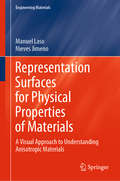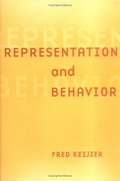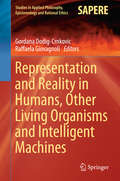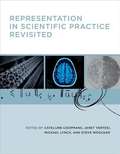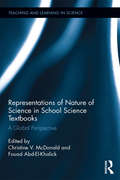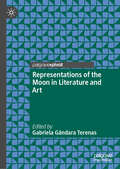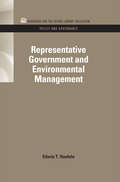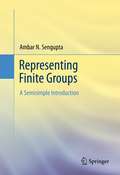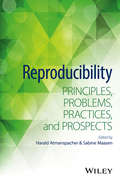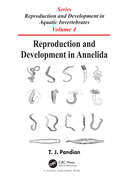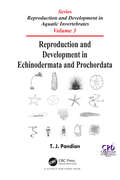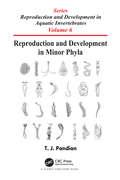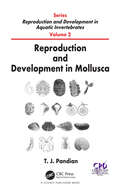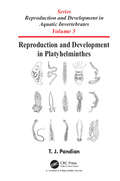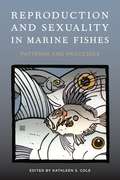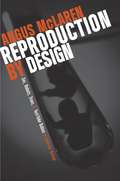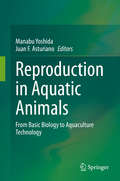- Table View
- List View
Representation Surfaces for Physical Properties of Materials: A Visual Approach to Understanding Anisotropic Materials (Engineering Materials)
by Manuel Laso Nieves JimenoThis textbook presents all the mathematical and physical concepts needed to visualize and understand representation surfaces, providing readers with a reliable and intuitive understanding of the behavior and properties of anisotropic materials, and a sound grasp of the directionality of material properties. They will learn how to extract quantitative information from representation surfaces, which encode tremendous amounts of information in a very concise way, making them especially useful in understanding higher order tensorial material properties (piezoelectric moduli, elastic compliance and rigidity, etc.) and in the design of applications based on these materials. Readers will also learn from scratch concepts on crystallography, symmetry and Cartesian tensors, which are essential for understanding anisotropic materials, their design and application. The book describes how to apply representation surfaces to a diverse range of material properties, making it a valuable resource for material scientists, mechanical engineers, and solid state physicists, as well as advanced undergraduates in Materials Science, Solid State Physics, Electronics, Optics, Mechanical Engineering, Composites and Polymer Science. Moreover, the book includes a wealth of worked-out examples, problems and exercises to help further understanding.
Representation Theory of the Symmetric Groups
by Tullio Ceccherini-Silberstein Fabio Scarabotti Filippo TolliA self-contained introduction to the representation theory of the symmetric groups, including an exhaustive exposition of the Okounkov Vershik approach.
Representation and Behavior
by Fred A. KeijzerFred Keijzer stresses that representations are the starting point for a set of processes that lead back to the external environment. They are used as theoretical components within an explanation of a person's outwardly visible behavior.
Representation and Reality in Humans, Other Living Organisms and Intelligent Machines (Studies in Applied Philosophy, Epistemology and Rational Ethics #28)
by Gordana Dodig-Crnkovic Raffaela GiovagnoliThis book enriches our views on representation and deepens our understanding of its different aspects. It arises out of several years of dialog between the editors and the authors, an interdisciplinary team of highly experienced researchers, and it reflects the best contemporary view of representation and reality in humans, other living beings, and intelligent machines. Structured into parts on the cognitive, computational, natural sciences, philosophical, logical, and machine perspectives, a theme of the field and the book is building and presenting networks, and the editors hope that the contributed chapters will spur understanding and collaboration between researchers in domains such as computer science, philosophy, logic, systems theory, engineering, psychology, sociology, anthropology, neuroscience, linguistics, and synthetic biology.
Representation in Scientific Practice Revisited
by Steve Woolgar Michael E. Lynch Janet Vertesi Catelijne CoopmansRepresentation in Scientific Practice, published by the MIT Press in 1990, helped coalesce a long-standing interest in scientific visualization among historians, philosophers, and sociologists of science and remains a touchstone for current investigations in science and technology studies. This volume revisits the topic, taking into account both the changing conceptual landscape of STS and the emergence of new imaging technologies in scientific practice. It offers cutting-edge research on a broad array of fields that study information as well as short reflections on the evolution of the field by leading scholars, including some of the contributors to the 1990 volume. The essays consider the ways in which viewing experiences are crafted in the digital era; the embodied nature of work with digital technologies; the constitutive role of materials and technologies -- from chalkboards to brain scans -- in the production of new scientific knowledge; the metaphors and images mobilized by communities of practice; and the status and significance of scientific imagery in professional and popular culture. ContributorsMorana Alac, Michael Barany, Anne Beaulieu, Annamaria Carusi, Catelijne Coopmans, Lorraine Daston, Sarah de Rijcke, Joseph Dumit, Emma Frow, Yann Giraud, Aud Sissel Hoel, Martin Kemp, Bruno Latour, John Law, Michael Lynch, Donald MacKenzie, Cyrus Mody, Natasha Myers, Rachel Prentice, Arie Rip, Martin Ruivenkamp, Lucy Suchman, Janet Vertesi, Steve Woolgar
Representation in Scientific Practice Revisited (Inside Technology)
by Steve Woolgar Janet Vertesi Catelijne CoopmansA fresh approach to visualization practices in the sciences that considers novel forms of imaging technology and draws on recent theoretical perspectives on representation.Representation in Scientific Practice, published by the MIT Press in 1990, helped coalesce a long-standing interest in scientific visualization among historians, philosophers, and sociologists of science and remains a touchstone for current investigations in science and technology studies. This volume revisits the topic, taking into account both the changing conceptual landscape of STS and the emergence of new imaging technologies in scientific practice. It offers cutting-edge research on a broad array of fields that study information as well as short reflections on the evolution of the field by leading scholars, including some of the contributors to the 1990 volume. The essays consider the ways in which viewing experiences are crafted in the digital era; the embodied nature of work with digital technologies; the constitutive role of materials and technologies—from chalkboards to brain scans—in the production of new scientific knowledge; the metaphors and images mobilized by communities of practice; and the status and significance of scientific imagery in professional and popular culture.ContributorsMorana Alač, Michael Barany, Anne Beaulieu, Annamaria Carusi, Catelijne Coopmans, Lorraine Daston, Sarah de Rijcke, Joseph Dumit, Emma Frow, Yann Giraud, Aud Sissel Hoel, Martin Kemp, Bruno Latour, John Law, Michael Lynch, Donald MacKenzie, Cyrus Mody, Natasha Myers, Rachel Prentice, Arie Rip, Martin Ruivenkamp, Lucy Suchman, Janet Vertesi, Steve Woolgar
Representations of Nature of Science in School Science Textbooks: A Global Perspective (Teaching and Learning in Science Series)
by Christine V. McDonald Fouad Abd-El-KhalickBringing together international research on nature of science (NOS) representations in science textbooks, the unique analyses presented in this volume provides a global perspective on NOS from elementary to college level and discusses the practical implications in various regions across the globe. Contributing authors highlight the similarities and differences in NOS representations and provide recommendations for future science textbooks. This comprehensive analysis is a definitive reference work for the field of science education.
Representations of the Infinite Symmetric Group
by Alexei Borodin Grigori OlshanskiRepresentation theory of big groups is an important and quickly developing part of modern mathematics, giving rise to a variety of important applications in probability and mathematical physics. This book provides the first concise and self-contained introduction to the theory on the simplest yet very nontrivial example of the infinite symmetric group, focusing on its deep connections to probability, mathematical physics, and algebraic combinatorics. Following a discussion of the classical Thoma's theorem which describes the characters of the infinite symmetric group, the authors describe explicit constructions of an important class of representations, including both the irreducible and generalized ones. Complete with detailed proofs, as well as numerous examples and exercises which help to summarize recent developments in the field, this book will enable graduates to enhance their understanding of the topic, while also aiding lecturers and researchers in related areas.
Representations of the Moon in Literature and Art
by Gabriela Gândara TerenasThis book brings together a collection of essays on the occasion of the fiftieth anniversary of the arrival of the first man on the moon – a time when tourist journeys to the moon, now a real possibility, were no more than a fantasy. Divided into four sections, illustrating different perceptions of the moon, the common aim of the essays in this book is to examine how mankind’s interest in the moon has been represented in Literature and the Arts, an objective underpinned by the desire to exploit the relationship between the so-called two cultures—the Humanities and Science—as C.P. Snow perceived them in his pioneering work (1959). The plethora of ways in which our companion satellite has been portrayed has led the authors of the essays to draw upon research from the history of science as well as from literary, cultural and artistic studies. In addition to analysing the impact on literature and music, of our arrival on the moon, whether real or imaginary, these studies also examine how writers along the centuries have appropriated the moon as a metaphor in order to project latent conflict, criticise the society or politics of their day, reflect upon scientific or technological discoveries or fantasise about journeys, encounters or imaginary realities.
Representative Government and Environmental Management (RFF Policy and Governance Set)
by Edwin T. HaefeleFirst Published in 2011. Routledge is an imprint of Taylor & Francis, an informa company.
Representing And Intervening
by Ian HackingThis 1983 book is a lively and clearly written introduction to the philosophy of natural science, organized around the central theme of scientific realism. It has two parts. 'Representing' deals with the different philosophical accounts of scientific objectivity and the reality of scientific entities. The views of Kuhn, Feyerabend, Lakatos, Putnam, van Fraassen, and others, are all considered. 'Intervening' presents the first sustained treatment of experimental science for many years and uses it to give a new direction to debates about realism. Hacking illustrates how experimentation often has a life independent of theory. He argues that although the philosophical problems of scientific realism can not be resolved when put in terms of theory alone, a sound philosophy of experiment provides compelling grounds for a realistic attitude. A great many scientific examples are described in both parts of the book, which also includes lucid expositions of recent high energy physics and a remarkable chapter on the microscope in cell biology.
Representing Finite Groups
by Ambar N. SenguptaThis graduate textbook presents the basics of representation theory for finite groups from the point of view of semisimple algebras and modules over them. The presentation interweaves insights from specific examples with development of general and powerful tools based on the notion of semisimplicity. The elegant ideas of commutant duality are introduced, along with an introduction to representations of unitary groups. The text progresses systematically and the presentation is friendly and inviting. Central concepts are revisited and explored from multiple viewpoints. Exercises at the end of the chapter help reinforce the material. Representing Finite Groups: A Semisimple Introduction would serve as a textbook for graduate and some advanced undergraduate courses in mathematics. Prerequisites include acquaintance with elementary group theory and some familiarity with rings and modules. A final chapter presents a self-contained account of notions and results in algebra that are used. Researchers in mathematics and mathematical physics will also find this book useful. A separate solutions manual is available for instructors.
Representing Space in the Scientific Revolution
by David Marshall MillerThe novel understanding of the physical world that characterized the Scientific Revolution depended on a fundamental shift in the way its protagonists understood and described space. At the beginning of the seventeenth century, spatial phenomena were described in relation to a presupposed central point; by its end, space had become a centerless void in which phenomena could only be described by reference to arbitrary orientations. David Marshall Miller examines both the historical and philosophical aspects of this far-reaching development, including the rejection of the idea of heavenly spheres, the advent of rectilinear inertia, and the theoretical contributions of Copernicus, Gilbert, Kepler, Galileo, Descartes, and Newton. His rich study shows clearly how the centered Aristotelian cosmos became the oriented Newtonian universe, and will be of great interest to students and scholars of the history and philosophy of science.
Representing the Environment (Routledge Introductions to Environment: Environment and Society Texts)
by George Revill John R. GoldThe development of the environmental movement has relied heavily upon written and visual imagery. Representing the Environment offers an introductory guide to representations of the environment found in the media, literature, art and everyday life encounters. Featuring case studies from Europe, the Americas and Australia, Representing the Environment provides practical guidance on how to study environmental representations from a cultural and historic perspective, and places the reader in the role of active interpreter. The book argues that studying representations provides an important lens on the development of environmental attitudes, values and decision-making.
Reproducibility: Principles, Problems, Practices, and Prospects
by Sabine Maasen Harald Atmanspacher"A comprehensive, insightful treatment of the reproducibility challenges facing science today and of ways in which the scientific community can address them." - Kathleen Hall Jamieson, Elizabeth Ware Packard Professor of Communication, University of Pennsylvania "How can we make sure that reproducible research remains a key imperative of scientific communication under increasing commercialization, media attention, and publication pressure? This handbook offers the first interdisciplinary and fundamental treatment of this important question." - Torsten Hothorn, Professor of Biostatistics, University of Zurich Featuring peer-reviewed contributions from noted experts in their fields of research, Reproducibility: Principles, Problems, Practices, and Prospects presents state-of-the-art approaches to reproducibility, the gold standard of sound science, from multi- and interdisciplinary perspectives. Including comprehensive coverage for implementing and reflecting the norm of reproducibility in various pertinent fields of research, the book focuses on how the reproducibility of results is applied, how it may be limited, and how such limitations can be understood or even controlled in the natural sciences, computational sciences, life sciences, social sciences, and studies of science and technology. The book presents many chapters devoted to a variety of methods and techniques, as well as their epistemic and ontological underpinnings, which have been developed to safeguard reproducible research and curtail deficits and failures. The book also investigates the political, historical, and social practices that underlie reproducible research in contemporary science studies, including the difficulties of good scientific practice and the ethos of reproducibility in modern innovation societies. Reproducibility: Principles, Problems, Practices, and Prospects is a guide for researchers who are interested in the general and overarching questions behind the concept of reproducibility; for active scientists who are confronted with practical reproducibility problems in their everyday work; and for economic stakeholders and political decision makers who need to better understand the challenges of reproducibility. In addition, the book is a useful in-depth primer for undergraduate and graduate-level courses in scientific methodology and basic issues in the philosophy and sociology of science from a modern perspective.
Reproduction and Adaptation
by C. G. Mascie-Taylor Lyliane RosettaIn the space of one generation major changes have begun to take place in the field of human reproduction. A rapid increase in the control of fertility and the understanding and treatment of sexual health issues have been accompanied by an emerging threat to reproductive function linked to increasing environmental pollution and dramatic changes in lifestyle. Organised around four key themes, this book provides a valuable review of some of the most important recent findings in human reproductive ecology. Major topics include the impact of the environment on reproduction, the role of physical activity and energetics in regulating reproduction, sexual maturation and ovulation assessment and demographic, health and family planning issues. Both theoretical and practical issues are covered, including the evolution and importance of the menopause and the various statistical methods by which researchers can analyse characteristics of the menstrual cycle in field studies.
Reproduction and Development in Annelida (Reproduction and Development in Aquatic Invertebrates)
by T. J. PandianThis book is a concise informative elucidation of all aspects of reproduction and development in annelids covering from arenicola to tubifex. Annelids flourish between 4,900 m depth to 2,000 m altitude; some of them occur in unusual habitats like hydrothermal vents and subterranean aquatic system (stigobionts). A few have no gut and acquire adequate nutrients through osmotrophism and/or engaging symbiotic microbes. In the absence of exoskeleton to escape predation, the 17,000 speciose annelids have explored bewildering modes of reproduction; not surprisingly, 42–47% of them are brooders. With 13,000 species, polychaetes are gonochores but some 207 species of them are hermaphrodites. Clitellates are all hermaphrodites; of them, 76 species are parthenogens, of which 56 are earthworms. Regenerative potency of annelids ranges from an organ to an entire worm from a single ‘seminal’ segment. The head, tail and both together can be regenerated 21, 42 and 20 times, respectively. However, the potency is limited to ~1% of polychaetes and Heterogamatic sex determination is reported to occur only in six polychaete species, although karyotype is known for 83 annelid species. In temperate polychaetes, a dozen neuroendocrines, arising mostly from the ‘brain’ regulates reproductive cycle. A complete chapter devoted to vermiculture, (i) recognizes the fast-growing candidate species, (ii) distinguishes 'layers' from 'brooders', (iii) indicates that the harvest of oligochaetes may reduce the input of nitrogenous fertilizer in the ricefield, and (iv) explores the scope for increasing wealth from waste.
Reproduction and Development in Echinodermata and Prochordata (Reproduction and Development in Aquatic Invertebrates)
by T. J. PandianEchinoderms and prochordates occupy a key position in vertebrate evolution. The genomes of sea urchin share 70% homology with humans. Researches on cell cycle in sea urchin and phagocytosis in asteroids have fetched Nobel Prizes. In this context, this book assumes immense importance. Echinoderms are unique, as their symmetry is bilateral in larvae but pentamerous radial in adults. The latter has eliminated the development of an anterior head and bilateral appendages. Further, the obligate need to face the substratum for locomotion and acquisition of food has eliminated their planktonic and nektonic existence. Egg size, a decisive factor in recruitment, increases with decreasing depths up to 2,000-5,000 m in lecithotrophic asteroids and ophiuroids but remains constant in their planktotrophics. Smaller ( 110 mm) asteroids generate planktotrophic eggs only. Publications on sex ratio of echinoderms indicate the genetic determination of sex at fertilization but those on hybridization, karyotype and ploidy induction do not provide evidence for heterogametism. But the herbivorous echinoids and larvacea with their gonads harboring both germ cells and Nutritive Phagocytes (NPs) have economized the transportation and hormonal costs on gonadal function. Despite the amazing potential just 2 and 3% of echinoderms undergo clonal reproduction and regeneration, respectively. Fission is triggered, when adequate reserve nutrients are accumulated. It is the most prevalent mode of clonal reproduction in holothuroids, asteroids and ophiuroids. However, budding is a more prevalent mode of clonal reproduction in colonial hemichordates and urochordates. In echinoderms, fission and budding eliminate each other. Similarly, autoregulation of early development eliminates clonal reproduction in echinoids and solitary urochordates. In pterobranchs, thaliaceans and ascidians, the repeated and rapid budding leads to colonial formation. Coloniality imposes reductions in species number and body size, generation time and life span, gonad number and fecundity as well as switching from gonochorism to simultaneous hermaphorditism and oviparity to ovoviviparity/viviparity.
Reproduction and Development in Minor Phyla (Reproduction and Development in Aquatic Invertebrates)
by T. J. PandianThe 26 recognized minor phyla comprise aberrant clades, as most of them terminate as blind offshoots. Untied from the discussion on their phylogenesis of minor phyla, this book is largely devoted, for the first time, to aspects of reproduction and development in minor phyletics. The minor phyla are not as speciose (1,795 species/phylum) as the major phyla (157,066 species/phylum) are. The accumulation of deleterious genes causes inbreeding depression among progenies arising from parthenogenesis, clonal multiplication and selfing hermaphrodites. The reason for the limited species diversity in minor phyla is traced to (i) eutelism in 65.7% of minor phyletics and (ii) existence of 21.6% clonals, (iii) 6.4% parthenogens and (iv) 1.2% selfing hermaphroditism. Gonochorism obligately requires motility to search for a mate. The combination of low motility and gonochorism from Placozoa to hemocoelomatic minor phyla has limited diversity to
Reproduction and Development in Mollusca (Reproduction and Development in Aquatic Invertebrates #2)
by T. J. PandianThis book is perhaps the first attempt to comprehensively project the uniqueness of molluscs, covering almost all aspects of reproduction and development from aplacophorans to vampyromorphic cephalopods. Molluscs are unique for the presence of protective external shell, defensive inking, geographic distribution from the depth of 9,050 m to an altitude of 4,300 m, gamete diversity, the use of nurse eggs and embryos to accelerate the first few mitotic divisions in embryos, the natural occurrence of androgenics in a couple of bivalves, viable induced tetraploids, gigantism induced by elevated ploidy, the complementary role played by mitochondrial genome in sex determination by nuclear genes and the uptake and accumulation of steroid hormone from surrounding waters. In molluscs, sexuality comprises of gonochorism ( 24%), protandry (
Reproduction and Development in Platyhelminthes (Reproduction and Development in Aquatic Invertebrates)
by T. J. PandianThis book is a comprehensive elucidation on aspects of reproduction and development in platyhelminthes covering from acoelids to taeniids. With the unique presence of neoblasts, turbellarians serve as a model for studies on cancer and senescence. Of ~ 27,000 species, ~ 77% are parasites; they are harmful to man and his food basket from livestock and fish. The stress hormone, cortisol level is responsible for susceptibility and resistance of the host. In digeneans, the propagatory multiplication potency is retained by all the larval forms and in either direction in sporocyst. The higher clonal diversity, mixing and selection in Second Intermediate Host (SIH) may purge inbreeding depression suffered by the fluke on propagatory multiplication in First Intermediate Host (FIH). Of 12,012 digeneans, 88% may engage 33,014 potential SIH species. They have the choice to select one among the available/awaiting 3.5 host species. The motility of vertebrate host and euryxenic flexibility/scope for selection of SIH species has increased lineage diversification in digeneans. The life cycle of cestodes is divided into aquatic and terrestrial patterns. The former includes (i) oncosphere and (ii) coracidium types and the latter (iii) hexacanth-cysticercoid, (iv) hexacanth-tetrathyridium and (v) hexacanth-cysticercus types. The share for the oncosphere, coracidium and hexacanth types is 17.0, 29.5 and 46.5%, respectively. The staggering fecundity and adoption of the intermediate host in the herbivorous/insectivorous food chain have enriched Taenioidea as the most (2,264) speciose order. Sex specific genes Smed-dmd 1 and macbol have been identified, and neuropeptides and dipeptides are involved in sexualization. Trematodes are unable to parasitize elasmobranchs, as they cannot suck body fluid/blood containing a high level of urea. Relatively higher fecundity supplemented with propagatory multiplication, incorporation of SIH in 88% species, clonal selection in SIH, and euryxenic flexibility and the widest choice for selection of SIH have led to the highest lineage diversification to render digeneans as the most speciose order in Platyhelminthes.
Reproduction and Sexuality in Marine Fishes
by Kathleen S. ColeMarine fishes represent astonishing diversity with respect to practically every aspect of their biology. Reproductive modes and sexual patterns are especially fascinating and provide deep insight into general evolutionary problems. In this volume, chapters focus on reproduction and sexuality among groups of fishes defined by habitat, taxon, and the reproductive processes that are critical for reproductive success. The book illustrates how knowledge of reproductive biology among marine fishes can help identify vulnerable and potentially vulnerable species in the face of changing environmental conditions and increasing human-based pressures.
Reproduction by Design: Sex, Robots, Trees, and Test-Tube Babies in Interwar Britain
by Angus McLarenModernity in interwar Europe frequently took the form of a preoccupation with mechanizing the natural; fears and fantasies revolved around the notion that the boundaries between people and machines were collapsing. Reproduction in particular became a battleground for those debating the merits of the modern world. That debate continues today, and to understand the history of our anxieties about modernity, we can have no better guide than Angus McLaren. In Reproduction by Design, McLaren draws on novels, plays, science fiction, and films of the 1920s and '30s, as well as the work of biologists, psychiatrists, and sexologists, to reveal surprisingly early debates on many of the same questions that shape the conversation today: homosexuality, recreational sex, contraception, abortion, euthanasia, sex change operations, and in vitro fertilization. Here, McLaren brings together the experience and perception of modernity with sexuality, technology, and ecological concerns into a cogent discussion of science’s place in reproduction in British and American cultural history.
Reproduction by Design: Sex, Robots, Trees, and Test-Tube Babies in Interwar Britain
by Angus MclarenModernity in interwar Europe frequently took the form of a preoccupation with mechanizing the natural; fears and fantasies revolved around the notion that the boundaries between people and machines were collapsing. Reproduction in particular became a battleground for those debating the merits of the modern world. That debate continues today, and to understand the history of our anxieties about modernity, we can have no better guide than Angus McLaren. In Reproduction by Design, McLaren draws on novels, plays, science fiction, and films of the 1920s and '30s, as well as the work of biologists, psychiatrists, and sexologists, to reveal surprisingly early debates on many of the same questions that shape the conversation today: homosexuality, recreational sex, contraception, abortion, euthanasia, sex change operations, and in vitro fertilization. Here, McLaren brings together the experience and perception of modernity with sexuality, technology, and ecological concerns into a cogent discussion of science's place in reproduction in British and American cultural history.
Reproduction in Aquatic Animals: From Basic Biology to Aquaculture Technology
by Manabu Yoshida Juan F. AsturianoThis book provides an up-to-date overview of the various reproductive systems of a variety of aquatic animals, from invertebrates to fishes. While all terrestrial animals use internal fertilization, aquatic animals have diverse reproductive systems. Some are internal fertilizers with or without mating, but many perform external fertilization. Because of this diversity, the reproductive systems of aquatic animals represent excellent models for the study of adaptive evolution and the species specificity of fertilization. In addition, many aquatic animals, including fish, crustaceans, and mollusks, are important as fishery and aquaculture resources. In this book, up-and-coming researchers examine reproductive systems in representative aquatic animals, covering both the basic knowledge and late-breaking results. Reproduction in Aquatic Animals: From Basic Biology to Aquaculture Technology will be of interest to graduate and postgraduate students in biology and agricultural sciences, as well as to researchers and technicians in the fields of reproductive biology and fishery science and to non-academics.
